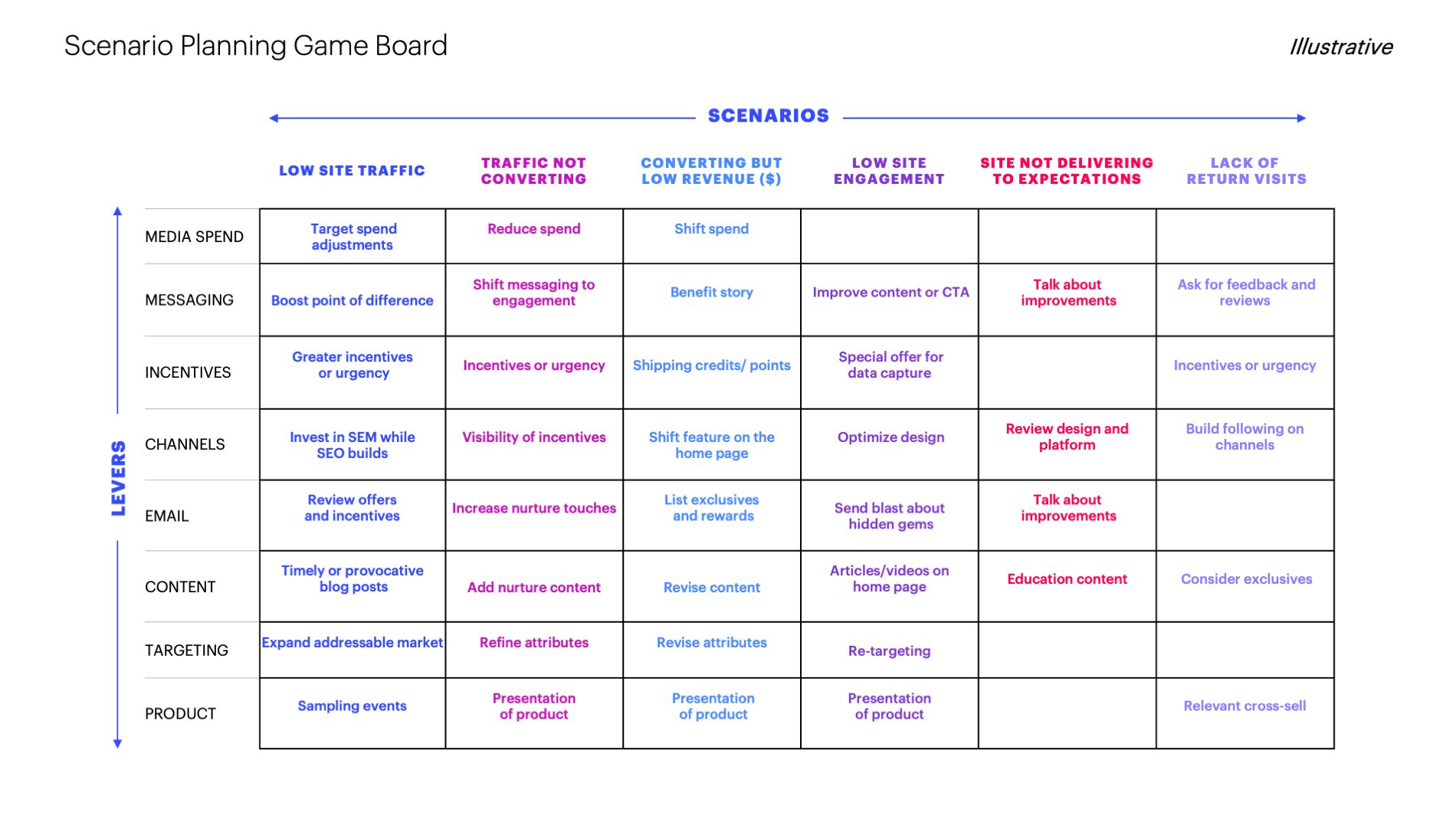No one knows the future. But the best marketing leaders don’t hide–they plan for multiple outcomes.
Today’s marketers often feel like they’re working in patchy fog. Is this a recession, or is a soft landing just ahead? Will “do more with less” be the corporate mantra for a few quarters—or the foreseeable future?
The practical answer is that we don’t know. That’s why modern marketers should use scenario planning to build agile and resilient marketing strategies. While marketing leaders and CMOs can’t predict the future, they can always plan for potential outcomes with scenario planning.
The start of the pandemic in the U.S. provides a perfect example. It wasn’t a scenario any company had forecast. Yet marketers moved fast. Initially, ad spending plans unraveled as sporting events stopped, stores and restaurants closed, and travel evaporated.
Within weeks or even days, companies learned they could shoot new content remotely, creating messages that reflected enormous social changes. Brands tore up their media plans. Traditional media spending in 2020 fell by 17%, and digital advertising increased by 31%, often resulting in a better return on advertising spending.
While uncertainty is a given, especially in this economy, effective scenario planning can mean the difference between simply surviving unexpected curveballs or thriving because of them.
Scenario Planning 3.0: A modern approach
Scenario thinking gained a place in the American business lexicon in the 1950s, popularized by Cold War futurists. And at its core, not much has changed.
By creating a series of plausible scenarios, organizations tell multiple stories about the future, measuring how ready the company is to prosper in each imagined reality. What are the potential disruptions? The new opportunities? How quickly would the enterprise be able to move to recover or capitalize on those future states?
The main benefit of scenario planning is more effective, efficient and durable marketing plans. But it also brings out the organization’s best thinking, requiring creativity and collaboration that leads to significant innovation and increased decision-making confidence. While it works in many areas, it’s most effective in new brand or product launches, ongoing acquisition or lead generation, customer loyalty and attrition risk.
Modern scenario planning allows companies to proactively address scenarios that may jeopardize the ability to reach any prioritized goal. And each step leads to strategic outcomes that will help marketing strategy thrive despite uncertainty.
Three steps to take when scenario planning your next marketing strategy
Think of scenario planning as a game. The one here is a game board we use to help workshop specific scenarios and prepare for potential outcomes.

Here are three steps to take when scenario-planning a marketing initiative.
1. Draft possible scenarios for an initial discussion
We recommend defining a short list of critical priorities for a specific marketing initiative rather than trying to scenario-plan for every single objective. To ensure you are tapping into the right preferences, collaborate with a cross-disciplinary team of stakeholders across marketing, sales, customer experience, operations and product.
Some common areas include:
- Low site traffic or site traffic declining
- Site traffic is not converting to sales
- Sales are resulting in low revenue
- Slow velocity to conversion
- Low customer engagement
- Lack of return customers
- Smaller size or value in shopping carts
2. Add and prioritize ideas across levers to address scenarios
Once you have identified key priorities, address the potential levers to pull. Some examples for marketers include:
- What would happen if we increased or shifted media spending?
- If we changed the messaging, would that improve customer engagement?
- Might we offer audiences different or more personalized incentives and offers?
- Would a shift in loyalty and rewards make a difference?
- Could we consider other channels, working with new influencers or product aggregators?
- How about new content and social strategies?
- Would increasing the number of touchpoints improve lead nurturing?
3. Codify and socialize the contingency plan
It’s essential that these initial plans are shared throughout the organization. But the job isn’t over. Companies often need additional sessions to follow up on hot topics and assign owners to chosen levers.
It’s best to schedule a contingency planning session at the end of an agreed-upon time frame to evaluate performance data to date. Leaders might integrate the scenario decision process into regular performance reporting sessions, similar to how they integrate optimization sessions in conventional campaign management.
During this phase of the process, internal communication channels become critical tools. It’s essential to ensure all stakeholders, from supply chain partners to investors, are current on pivot-ready strategies.
Scenario-plan your path to success
While uncertainty is a given, modern marketing leaders are not leaving their success to luck. With thoughtful scenario planning, they can develop more resilient marketing plans with an array of responses to meet multiple realities. And if and when rapid change comes, they’ll know what to do, or at least what to try, to deliver on marketing goals.

Mat Zucker is a senior partner and co-leader of Prophet’s global marketing and sales practice, where he helps clients unlock uncommon growth through marketing, content and communications.
















